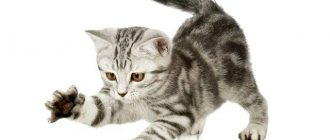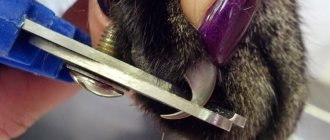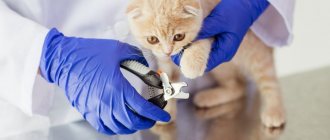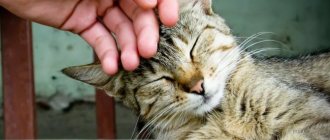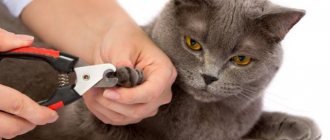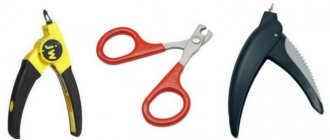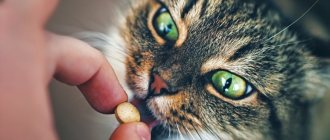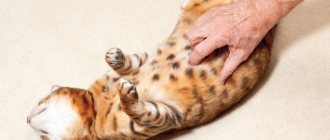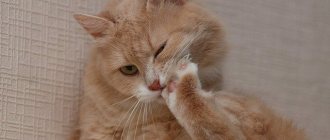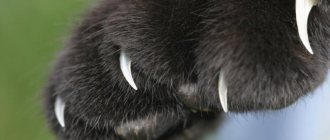Sharp cat claws serve as weapons for pets. They help in hunting and movement, but in a home environment they bring discomfort to their owners. They have a complex structure and are made of several layers. Therefore, you should carefully care for the claws: systematically trim or change the anti-scratch guards. In addition, it is advised to accustom the kitten to a scratching post from childhood so that it does not damage the furniture.
Why take care of your claws?
Any cat itself maintains its claws in normal condition. She sharpens them regularly, often on furniture or carpet. If you don't take any measures, a sofa, armchair or wallpaper will quickly turn into rags. Ungroomed claws damage not only furniture. A cat can run wildly across the carpet and get its claw stuck. In a panic, she will easily rip it out, which will cause her great pain. If you have a cat in the house, it is important to monitor not only its health and fur, but also the condition of its claws.
Sources[edit | edit code]
- ↑ 1.01.1 Erowele GI, Kalejaiye AO. Pharmacology and therapeutic uses of cat's claw. American Journal of Health-System Pharmacy. 2009; 66:992-995.
- Carvalho MV, Penido C, Siani AC, Valente LMM, Henriques MGMO. Investigations on the antiinflammatory and antiallergic activities of the leaves of Uncaria guianensis (Aublet) JF Gmelin. Inflammopharmacology. 2006; 14: 48-56.
- Piscoya J, Rodriguez Z, Bustamante SA, Okuhama NN, Miller MJS, Sandoval M. Efficacy and safety of freeze-dried cat's claw in osteoarthritis of the knee: Mechanisms of action of the species Uncaria guianesis. Inflammation Research. 2001; 50: 442-448.
- Miller MJS, Mehta K, Kunte S, Raut V, Gala J, Dhumale R, Shukla A, Tupallli H, Parikh H, Bobrowski P, Chaudhary J. Early relief of osteoarthritis symptoms with a natural mineral supplement and a herbomineral combination: A randomized controlled trial. Journal of Inflammation. 2005; 2(11): 1-14.
- Miller MJS, Ahmed S, Bobrowski P, Haqqui T. The chondroprotective actions of a natural product are associated with the activation of IGF-1 production by human chondrocytes despite the presence of IL-1β. BMC Complementary and Alternative Medicine. 2006; 6(13): 6-13.
Scratching post - the main accessory
It is important for cats to sharpen their claws regularly. This is how they remove the top chitinous layer, under which the young claw hides.
Animals that walk outside sharpen their claws on trees. Domestic cats choose some kind of “victim” for this: a sofa, walls, carpet or chair. To protect your furniture, purchase a scratching post: one or several, according to the number of rooms in the house. Pet stores offer a huge selection of these accessories. Which one to choose? Take a closer look at your pet. If he likes to tear up the sofa, choose an upright model. If your cat likes carpet, buy a horizontal scratching post. There are also special overlays for furniture, scratching posts, houses, etc. You can simply nail an ordinary board if such a design decision does not bother you.
Tool selection
Some owners think about how to trim a cat's claws with scissors. It happens that the procedure is performed with manicure or household tools. But this is not a very good solution, because this way you can injure the animal during the cutting process.
Pet stores and veterinary pharmacies sell special guillotine scissors, also called nail clippers and trimmers. They are much easier to use, and the risk of injury to the animal is minimized.
There are also blisters. They resemble manicure scissors. But the blade of the tool is adjusted to the curve of a cat's claw, which greatly simplifies the procedure.
Use a file to file down the claws after cutting. This allows you to achieve a neat shape.
You will also need a means to stop the bleeding - in case the animal is injured, and cotton wool. Hydrogen peroxide, iodine, brilliant green, baby powder, and potassium permanganate will do.
How to train a cat to use a scratching post
Training is best started at an early age. But adults also make good friends with the new “simulator”.
To stop an animal from damaging furniture, you can spray it with water during each act of vandalism. You can also rub the furniture with orange or lemon peel - cats cannot stand the smell of citrus fruits. If your cat flatly refuses to approach the scratching post, rub the surface with catnip or a spray based on it. A cat's reluctance to sharpen its claws where they should be may be due to an unsuitable scratching post. It may be too loose or smooth. Sometimes it is worth changing several accessories to find one that your pet will like.
Details
Tools
To carry out the procedure you will need:
- Claw clipper or guillotine,
- Buff or glass file,
- Cotton pads;
- Peroxide and chlorhexedine;
- Trimmer;
- Cat and treats.
The first two points are required, although many owners claim that they can do it just fine with scissors. Yes, you can trim your cat’s claws with regular scissors, but it’s not necessary. The thing is that the claw has a specific shape and a guillotine or nail clipper is anatomically more comfortable and performs the procedure faster than using scissors.
A buff or file is needed to conveniently and quickly remove the inevitable burrs on the cut. The cat is not a lady, she will not sit in a basin with a bath to soften the claw, which means the hard tissue of the claw will have to be cut off as is.
It is better to always have cotton pads, peroxide and chlorhexedine on hand, even if you have already carefully cut off the claws a hundred times or have experience with this procedure for dogs. Unforeseen injury can always happen.
A trimmer is required as a comprehensive tool, since especially fluffy breeds also need to trim excess fur between their toes at home.
You will need something tasty to reduce your cat’s stress, since even a cat that has been accustomed since childhood will still never like two procedures – trimming its claws and cleaning its ears.
Carrying out the procedure
The most important part in the procedure is not to catch the cat and cut off the claw, but to do it anatomically correctly, without damaging the pet’s nail bed.
The structure of a cat's claw is the same as that of a dog - if the plate is light, then you can always see where the “meat” begins under the keratinized layer. So you need to cut it off 2-3 millimeters from this border. The purpose of the procedure is to reduce discomfort and reduce the risk of injury, and not to cause pain to the pet.
IMPORTANT: The cutting line should be parallel to the ground line and not at any angle or perpendicular to the paw.
To properly trim a cat's claws, take your pet in your arms and sit with him next to the objects for the procedure. Touch your fingers, the cat should get used to the sensations. Then sit the animal so that it is convenient for you to hold the paw with one hand and cut the hair with the other. If sedative measures do not lead to results, then ask someone to hold the cat tightly, and proceed to the cut yourself.
Apply gentle pressure to the pad of your cat's palm so that the cat releases its claws. If you are afraid to cut off the claw right away, you can first mark it with a marker to see exactly where the color is superfluous, and where the flesh with blood vessels and the free edge that cannot be cut are visible.
Cut off all excess, then go over the burrs with a file several times. There is no need to cut out the shapes, just sand the edge. If the cat twitches or you cut off too much, quickly treat the wound with chlorhexedine and peroxide, and also observe how the pet feels for several days. If the cat immediately begins to limp heavily or has a fever and refuses to eat, take the patient to the veterinarian; you could have gotten an infection or the injury was more serious than a simple cut.
Cat manicure
Nails need to be trimmed in the following cases:
- The cat scratches household members or, even worse, children.
- The animal spoils the furniture and does not want to get rid of this bad habit.
- To prevent claws from growing into the fingertips of older pets.
- Before grooming a cat.
Important: if a cat walks outside, its claws cannot be trimmed. In case of danger, the pet will not be able to escape on the tree.
The procedure requires a special tool – a nail clipper. Ordinary scissors will not work - the claw will only peel off and not be cut off. These can be cutters with a limiter, scissors with rounded slots, or guillotine pliers.
Step-by-step instruction
The step-by-step process of trimming a cat's claws looks like this:
- The animal is placed on your lap and calmed down. Take one paw in your hand and fix the cat’s finger between yours, lightly pressing on the pad. The nail graft will come out.
- By looking at the light, the owner can easily determine where the blood vessels end.
- The tweezers are placed perpendicular to the nail below the level of the pulp and in one movement they cut off the tip of the plate.
- Sharp cuts are smoothed using a nail file.
- All claws are treated this way.
- After the procedure is completed, the cat is praised, given a treat, and petted. The animal will retain pleasant memories of the process and will be more willing to agree to it next time.
How to trim claws correctly
If you trim the claws correctly, the animal will not be hurt. It is important not to touch the living part of the claw with nerves and blood vessels. That is, you can only cut off the transparent part.
For the procedure, take the animal, press on its paw so that the claws protrude. Using gentle, confident movements, cut off the transparent part.
If the claws are dark, the living part is not visible. In this case, you should cut off the edges millimeter by millimeter, monitoring the pet’s reaction. Remember that on the hind legs the claws are shorter, which means there is less dead edge.
You need to be calm during the procedure. The cat will sense your excitement and perceive the haircut as a threat. If she does not want to sit quietly, it is better to carry out the procedure together. You need to encourage the animal in every possible way and praise it for good behavior.
Nails should be trimmed approximately once a month. But everything is individual. Inspect the pads regularly: if the claws have grown, repeat the procedure.
What chemotypes exist?
Two chemotypes of Peruvian U. tomentosa have been identified: the tetracyclic oxindole alkaloid type (tetracyclica) and the pentacyclic oxindole alkaloid type (pentacyclica).
The latter type is known to have immunoenhancing properties, while the former type is immunosuppressive. Initially, these chemotypes were largely ignored in cat's claw preparations. But over time, the chemical profile began to be studied better.
As a result, it became known that pentacyclic alkaloids are found more in the bark, and tetracyclic alkaloids - in the leaves and stem of the plant. Accordingly, the leaves were considered unhealthful for commercial purposes.
As for the possibility of the emergence of a “new chemotype,” the plant does not change its chemical composition for five years. Again, there are two species of cat's claw - U. tomentosa and U. Guianensis. They have a similar chemical composition, but different ratios of these alkaloids.
It is generally accepted that the number of Uncaria pubescenta has decreased significantly in the Peruvian rainforest due to overharvesting over the past few years. And the second variety, U. guianensis, which is easier to find, is often used by unscrupulous producers as a replacement.
Other significant studies
Additionally, the antitumor properties of the plant were studied. Five alkaloids do have anti-leukemia properties, and various root and bark extracts have demonstrated antitumor and anti-cancer properties.
Swedish researchers documented that cat's claw suppresses the growth of lymphoma and leukemia cells in vitro in 1998.
Italian scientists reported in 2001 that cat's claw inhibited the in vitro growth of human breast cancer cells by 90%.
Another important area of research has focused on the plant's anti-inflammatory properties. Plant sterols and antioxidant chemicals, as well as quinic acid glycosides, have been recognized as the most potent anti-inflammatory components of the plant. In 2002, another group was also included in these substances - carboxyalkyl ethers.
Scientists say that cat's claw (especially its glycosides) inhibits inflammation from 46 to 89% in various in vivo tests. These results support the long history of using cat's claw for arthritis and rheumatism, as well as other inflammatory diseases of the stomach and intestines.
In 2000, researchers in Argentina concluded that cat's claw is an extremely powerful antioxidant.
The alkaloids rhynchophylline, hirsutine and mitraphylline have demonstrated hypotensive and vasodilatory properties. Rhynchophylline is known to prevent the formation of blood clots in blood vessels, dilate peripheral blood vessels, reduce heart rate and lower blood cholesterol levels.
New research suggests that cat's claw may benefit people with Alzheimer's disease, possibly due to its proven antioxidant properties.
The immunostimulating alkaloids of cat's claw, pteropodine and isoperopodine, also have other properties. They have a positive effect on brain neurotransmitters called serotonin receptors.
These receptors are targets for drugs used to treat a variety of conditions, including depression, anxiety, eating disorders, chronic pain conditions and obesity.
Alternatives to Nail Trimming
Many owners, tired of dealing with cat hooliganism, resort to a last resort - amputation of claws (onychectomy). During this procedure, the animal's claws are removed along with the finger bones. This is a very traumatic operation. Physical recovery alone will take six months. But the cat will never recover morally.
Without claws, the animal feels vulnerable. Coordination of movements is impaired. Many pets adapt, but many do not and die.
Claw amputation is prohibited in many EU countries and is considered cruelty.
There is another operation - tendectomy. During it, pieces of tendons are cut out. After this, the cat cannot release its claws. The operation is also crippling, leading to injury due to the inability to maintain balance.
Covers for claws
To protect furniture and people from cat claws, soft caps made of silicone or vinyl (“anti-scratch caps”) are used. They are glued to the claw with special glue.
But such cases are also not safe. The secretion of secretion from the glands of the fingertips does not stop. It begins to accumulate under the “anti-scratch”, which can lead to inflammation.
Also, cats often tear off the covers with their teeth and eat them. It is better to use such overlays for a short time. For example, until the baby grows up and understands that you cannot pull the cat’s fur and tail.
So, as you can see, the best solution for caring for the claws of cats and cats is a scratching post. It is necessary to teach a kitten from infancy not to scratch furniture and people, and then extreme measures will not be required.
Beneficial features
- Treatment of joints. The dietary supplement helps relieve the symptoms of osteoarthritis and rheumatoid arthritis. Particularly effective against rheumatic joint damage is an extract obtained from a special strain of cat's claw containing pentacyclic oxindole alkaloids, which are modulators of the immune system.
- Help in the treatment of cancer. The plant extracts were found to be able to kill cancer cells in an in vitro system. Despite the fact that the experiments were carried out “in test tubes,” these drugs are now beginning to be considered as additional medications in the treatment of cancer.
In addition to the fact that they can destroy degenerated cells, cat's claw supplements reduce the side effects of chemotherapy.
Chemotherapy drugs often damage the DNA of healthy cells. And this leads to the development of a huge number of complications. Cat's claw extracts improve the repair (restoration) of DNA molecules after such damage.
In addition, they enhance the proliferation (formation) of leukocytes. This is also important to minimize the negative effects of chemotherapy, since this type of treatment often leads to a sharp decrease in immunity.
- Skin protection from ultraviolet radiation. Uncaria supplements enhance DNA repair not only after chemotherapy, but also after prolonged exposure of skin cells to ultraviolet radiation. The effectiveness of dietary supplements in this regard is so high that they are even called “natural sunscreen.”
- Treatment of hypertension. Cat's claw contains the alkaloid hirsutine, which is a blocker of calcium channels in the heart and blood vessels. Blockade of calcium channels leads to dilation and relaxation of blood vessels and, as a result, to a decrease in blood pressure.
- Strengthening immunity. Improving DNA repair processes and leukocyte proliferation is important not only to eliminate the side effects of chemotherapy, but also to strengthen the immune system. Healthy volunteers taking the supplements were shown to demonstrate a “statistically significant” increase in immunity compared to the placebo group.
- Treatment of herpes. Uncaria extracts contain special polyphenolic compounds, which, together with oxindole alkaloids and glycosides of quinovic acid, have significant antiherpetic activity.
- Improving the functioning of the digestive system. Cat's claw extracts, primarily Uncaria tomentosa, have proven themselves to be a natural remedy for treating various gastrointestinal diseases: colitis, gastritis, diverticulum, hemorrhoids, stomach and duodenal ulcers. The activity of dietary supplements is so great that they are recommended to be taken even by those who suffer from such a serious illness as Crohn's disease.
Cat's claw - medicinal properties
The raw materials from this vine cannot be called cheap, and the reason for this is not only expensive foreign supplies, but also not very extensive production. Uncaria grows very slowly; in order for it to be suitable for creating a medicine, it must grow for at least 20 years. The list of its valuable properties includes antioxidant, anti-inflammatory, antiviral, and antitumor properties.
Having studied the cat's claw plant, researchers identify the most valuable medicinal properties as follows:
- destruction of tumor cells;
- improvement of blood condition;
- blocking viruses in cells;
- the ability to block the formation of free radicals without side effects.
Cat's claw - indications for use
The timing of how long to take cat's claw depends on the diagnosis and condition of the patient; on average, the time is limited from a month to three. It is known that the inhabitants of Peru used the plant to treat stomach and intestines, colds, joint diseases and even impotence. Scientists explain the strong immunostimulating effect, which surpasses even ginseng, by the fact that the medicine acts on the body at the cellular level.
What are the indications for use of cat's claw:
- viral and bacterial infections;
- allergy;
- inflammation;
- oncology;
- ulcer;
- hormonal imbalance;
- arthritis;
- diabetes;
- skin diseases;
- pain in muscles and joints;
- blood diseases;
- poisoning;
- mental and nervous system problems;
- menstrual pain, gynecological problems;
- flu;
- herpes;
- thrombophlebitis;
- varicose veins;
- AIDS virus.
Cat's claw - contraindications
Cat's claw also has properties to treat genital herpes, hepatitis, chlamydia, and without relapse, it improves digestion and heals the gastric mucosa. But even with all its healing abilities, it cannot be used by everyone, without exception. The drug should not be given to pregnant women, as it can cause uterine contractions and miscarriage, to nursing mothers, and to children. It is known that Peruvian women used decoctions as a contraceptive.
In what cases is cat's claw strictly contraindicated:
- tuberculosis;
- autoimmune diseases;
- hypertension;
- during organ transplantation, rejection may begin;
- when taking medications that relieve heart rhythm disturbances;
- when taking blood thinners;
- before going to the dentist.

